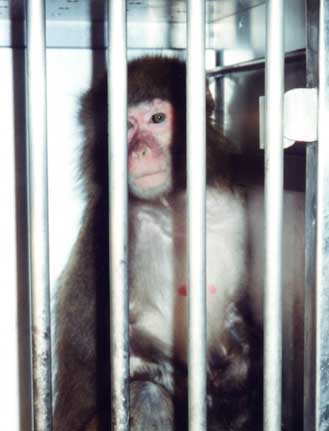 |
   |
| HOME > Wild Life > Japanese Macaques Caretakings |
|
|
|||||||||
ALIVE
All Life In a Viable Environment
5-18-10-102, Honkomagome, Bunkyo-ku, Tokyo, 113-0021
Japan
Tel.+81-3-5978-6272
Fax..+81-3-5978-6273
![]()
Anti Vivisection Action Network
ALIVE Research:
|
 |
The Japanese Macaque is a primate indigenous
to Japan. It is the most northern-living non-human primate
and it is also known as “the snow monkey.” In 2008, ALIVE conducted a nationwide survey to
assess the daily care condition of Japanese Macaques
in captivity.
|
System for Permission to Keep
Japanese Macaques.
Japanese Macaques fall under the category of“specified animals”.
When keeping specified animals, permission must be obtained from
the prefectural governor having jurisdiction over the location
of the
facility. According to the law, microchips or tattoos that identify
individual monkeys are required when keeping specified animals.
Permission and identification must be properly obtained and done.
Additionally, local governments may visit the facilities to conduct
onsite inspections. It is also required to have a sign that informs
the public that a facility has specified animals. This applies
to all facilities that keep specified animals, including animal
experiment facilities, zoos, and private homes.
Number of Japanese Macaque Facilities
and the Purpose of Them.
ALIVE sent a nationwide survey to all prefectural governments
in Japan. The purpose of the survey was to find out about the
actual caretaking conditions of Japanese Macaques, its purpose,
and the number of facilities and the number of Macaques that are
kept at facilities (100% response rate.)
The Purposes:
1) For companionship. (as pet animal)
2) For Sale. (at pet shops)
3) For Exhibition (zoos), Circus, Entertainment.
4) Animal Experimentation.
5) Others.
The survey also found that in Japan, there are 335 facilities
that keep Japanese Macaques: 54% of them use the Macaques for
exhibition, 41% for experiments and 3% for companionship.
The Number of Japanese Macaques Used
in Experiments.
Japan is like a “developing country” in which no regulations
for animal experimentations exist. The number of animal experiment
facilities and animals used for experiments is unknown. However,
we can have some idea of the number and condition of Japanese
Macaques at experiment facilities, since keeping Japanese Macaques
requires permission from local governments. ALIVE demanded experiment
facilities to disclose more information concerning Japanese Macaques
at the facilities. We discovered that there are 52 facilities
in 25 local governments. (There were 5 facilities that have caretaking
permission, but did not actually have any Macaques.)
Some other facts we do have are as follows: The facilities that keepJapanese Macaques had received permission to keep 3,536 , but only 1,937 are kept at these facilities. Of these there are 3 facilities that breed monkeys for the purpose of experimentation and these facilities have 1,305 monkeys in total. Also there are 2 research facilities that keep 22 and 584 are being used for medical experimentations.
ALIVE had strongly opposed the use of wild Japanese Macaques that are captured to exterminate in experiments and successfully ended the use of wild-caught Japanese Macaques in experiments. We need to continuously monitor the situation.
Cage Sizes:
At all experiment facilities that were part of the survey, the
cages are very small and a sense of animal welfare did not exist.
For example, at the Graduate School of Dental Medicine Hokkaido
University, their cages are 50cm width, 57cm height, and 52cm
depth.
At Tokyo Medical and Dental University, their cages are 55cm width,
60cm height, and 55cm depth. Japanese Macaques live in close association
with their mothers. Keeping a Macaque in a single cage will cause
great mental and physical damage to the animal. The welfare for
caring of primates has to be improved.
Onsite Inspection:
When local governments conducted onsite inspections, only 11 local
of them used any type check form. The inspection criteria varied
from local government to local government. Even if there was a
check form,
the questions were only focused on the safety of humans, and there
was no consideration of animal welfare. The criteria for care
of primates must be established and inspections should be done
based on the
criteria.
| |